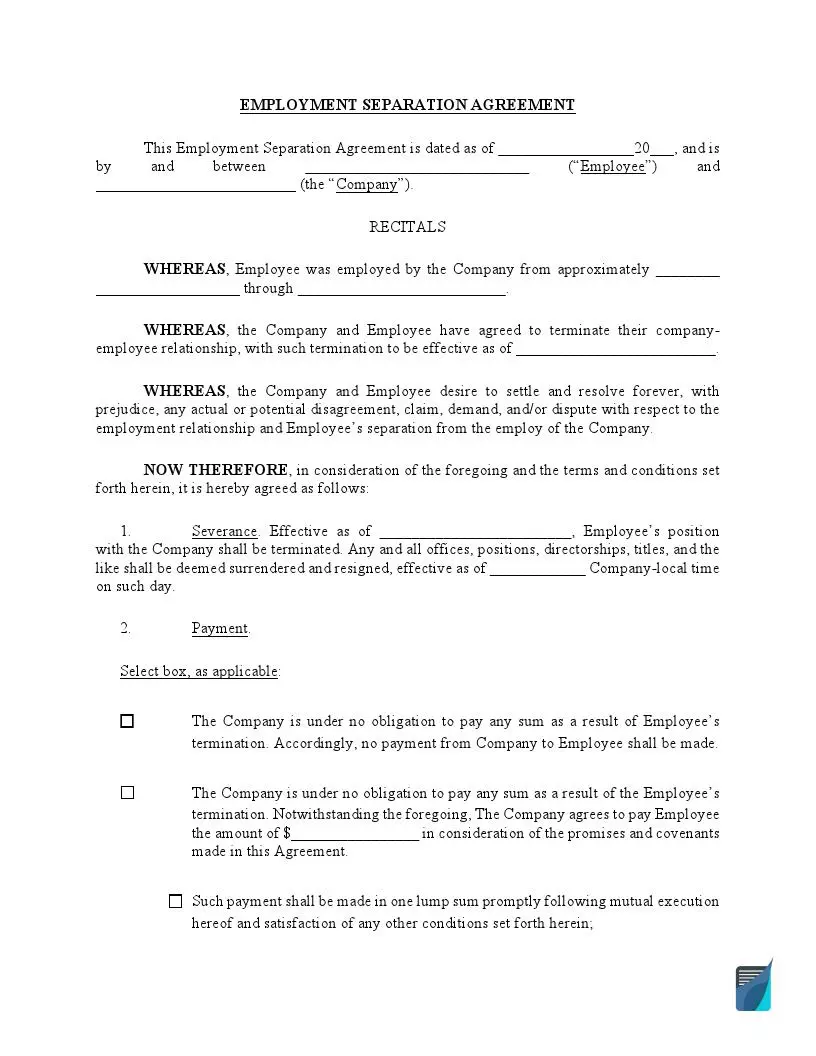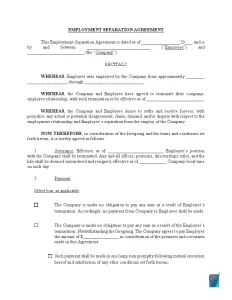Employment Separation Agreement
An employee separation agreement is a crucial document that outlines the terms and conditions under which an employee departs from a company or organization, thereby ending the employment relationship. This legally binding contract, agreed upon by both the employer and the employee through mutual agreement, helps prevent future disputes and liabilities that may arise from the employee’s termination. Commonly, the agreement includes provisions such as severance pay, benefits continuation, and confidentiality clauses to protect both parties’ interests.
This guide will provide essential information and a customizable template to help you create a well-structured employee separation agreement that caters to your organization’s needs. Although the agreement is not legally required, implementing it can safeguard your organization against potential legal issues and ensure a smoother transition for both parties. Additionally, we will discuss the importance of adhering to state and federal regulations when drafting and executing such agreements.

Build Your Document
Answer a few simple questions to make your document in minutes
Save and Print
Save progress and finish on any device, download and print anytime
Sign and Use
Your valid, lawyer-approved document is ready
Why Use an Employee Separation Agreement?
An employee separation agreement serves as a tool to protect the interests of both the organization and the departing employee. By outlining the terms and conditions of the separation, this legally binding document helps ensure that both parties understand their rights and responsibilities, making the transition smoother and minimizing the risk of future disputes.
For instance, if an employee is terminated on questionable grounds, they should carefully review the separation agreement to understand the rights they may be relinquishing. Likewise, employers should craft agreements that adhere to legal requirements and protect their business interests.
Common reasons for employment separation include:
- Performance issues. If an employee consistently fails to meet performance expectations, this may lead to termination.
- Retirement. As employees reach retirement age, they may choose to leave their positions, making way for new talent in the organization.
- Financial considerations. Employers may need to lay off employees to cut costs during difficult financial times, while employees might seek better-paying opportunities elsewhere.
- Relocation. Employees may need to leave their positions if they move to another city for personal reasons.
- Family priorities. Employees may choose to prioritize spending time with their growing families, putting their careers on hold.
It’s crucial for both parties to examine the clauses of the employee separation agreement carefully. If the language is too complex or unclear, seeking professional legal advice is recommended. By ensuring that the agreement serves the interests of both the employer and the employee and is in line with the relevant employment act, a fair and balanced separation can be achieved, reducing the likelihood of future disputes, including wrongful termination violations or legal proceedings pertaining to verbal or written agreements.
Key Components of a Separation Agreement Template
An employee separation agreement template typically includes the following elements:
- Separation details: This section outlines the date of separation, the company’s identification, and the reason for separation, such as termination, resignation, or retirement.
- Waiver of claims: This clause stipulates that by signing the agreement, the employee acknowledges that they are relinquishing any right to pursue legal action against the company, including those related to written agreements previously entered into. Both employees and employers should carefully review this section to ensure it is fair and legally compliant.
- Severance: While the law may only require payment of outstanding wages or unused vacation time, employers often offer additional incentives, such as extra pay or temporary continuation of health insurance, to encourage employees to sign the separation agreement.
- General payments: This section details any other financial compensation the employee may receive upon signing the agreement.
- Non-compete clause: A non-compete clause, which may have been part of the initial employment contract, restricts the employee from becoming a direct competitor or working for a competing organization for a specified period after termination.
- Non-disclosure clause: This essential component of the agreement prevents the employee from disclosing sensitive or proprietary information after leaving the company, protecting the organization’s intellectual property and trade secrets.
- Non-disparagement clause: This clause prohibits the employee from making negative or damaging public statements about their former employer after the separation.
By incorporating these components into your employee separation agreement, you can create a comprehensive and legally sound document that addresses the needs and concerns of both parties.

Filling Out the Separation Agreement Template
Step 1: Identify the parties
The first step is identifying the employer and employee and indicating the agreement’s date. You’ll need to fill in the following details:
- Employment separation agreement date. This agreement must mention the date when both parties will start obliging to follow its term.
- Employer. The employer is the first party, and this section must include the full legal name of the business.
- Employee. The employee is the other party of the agreement and must be filled with their full name and complete mailing address.
Step 2: Enter the end date of employment
Next, you are expected to indicate the end date of employment and set the paid time frame. The end date of employment includes the last date when the employee will be obliged to work for the employer or company. Also, the period for which an employee works for the company must be appropriately calculated, and the employee must be provided with the payment for the same.
Step 3: Provide severance details
Further, you need to check for the severance payment in the following manner:
- No consideration. In case there is no severance to be paid to the employee, the first box needs to be checked, which means that the tenure of employment and payment for the work will satisfy the employer’s payment obligation to the worker.
- Severance in multiple payments. If severance is to be paid, you may select severance in the multiple payments option. This option is selected for further supporting information items the employee needs, such as the final date of payment, frequency of payments, and others.
- Severance in a single payment. Sometimes the employer is obligated to provide severance in one go. If this is the case, then choose the relevant checkbox definition and provide the amount of money to the concerned person.
- Other severance payments. You can continue to item A if there is any additional clearance payment. Otherwise, no other severance should be selected.
Step 4: Check for return of property
Next, you need to check for the return of property by the employee as follows:
- No obligation. At the time of exit of a worker from the company, the no-obligation checkbox should be marked if they are not required to return any property to the company.
- Employee liable to return. If the company expects the employee to return any property during their exit from the company, the second checkbox should be marked.
- Return date. If the employee is expected to return the property, it must be received within a specific deadline, which must be filled in item A of Article IV.
Step 5: Specify the non-compete clause
The fifth step is to read and complete the non-compete clauses carefully in the agreement:
- No non-compete. There is a time frame allowing the employee to seek a job from their former employer’s competitor. In case of restriction of the above statement, mark the first checkbox in Article V.
- Non-compete condition. If the employee does not wish to take a new job in a similar industry, mark the second checkbox from Article V.
- Industries. In this, you need to mention all the industries the employee will be restricted from working in after their termination from the current industry.
- Term. Non-compete conditions do not apply to an employee’s lifetime; therefore, it is essential to mention the term when such conditions apply. It needs to be filled in item B.
- Location. Non-compete conditions between the employer and the employee also come with geographical boundaries. The checkbox provided in item C can be marked and filled for such purposes.
- International non-compete. Select an international statement if the conditions in the agreement apply to geographical boundaries outside.
Step 6: Provide employees benefits
This is one of the vital steps in filling out the agreement. You will have to enter the profits provided in the employer-employee relationship and add the last date when the employer must provide such an advantage to their employee.
Step 7: Consider relevant laws
Lastly, you must fill in the state’s name and other relevant details concerning the governing law. It is essential to mention the state’s name within the jurisdiction of which these agreements will be valid. The name must be mentioned in Article XVI.
Step 8. Sign the agreement
Employer’s and employee’s signatures and names must be included in the agreement.
Frequently Asked Questions
What is a severance package?
A severance package is a combination of payments and benefits provided to an employee upon involuntary termination of their employment. It often includes items such as salary continuation, payment for unused vacation time, and extended health insurance coverage. Employers who offer attractive severance packages generally experience a smoother and more amicable termination process.
Can an employee revoke a separation agreement?
Yes, employees have a legally recognized revocation period during which they can change their minds and revoke the signed agreement. The standard revocation periods are:
- Seven days for employees under 40 years old
- Twenty-one days for employees 40 years old and above
What if the employee won't sign the agreement?
If an employee refuses to sign the separation agreement, the company can still proceed with the termination. However, the employee will not receive the benefits outlined in the agreement, such as severance pay, and may retain the right to pursue legal action against the company, including cases of wrongful termination violation or disputes related to verbal or written agreements. It’s recommended both parties consult with legal counsel to ensure their interests are protected.
How many rights will an employee be giving up upon signing the agreement?
The specific rights an employee relinquishes upon signing a separation agreement depend on the terms and clauses included in the document. It’s essential for employees to carefully review clauses such as non-compete, non-disclosure, and non-disparagement agreements. If the language is unclear or difficult to understand, seeking legal advice is highly recommended.